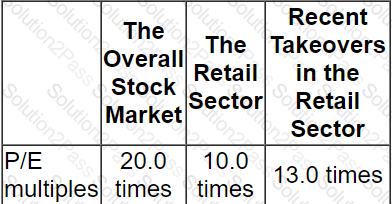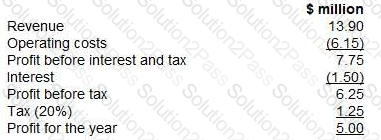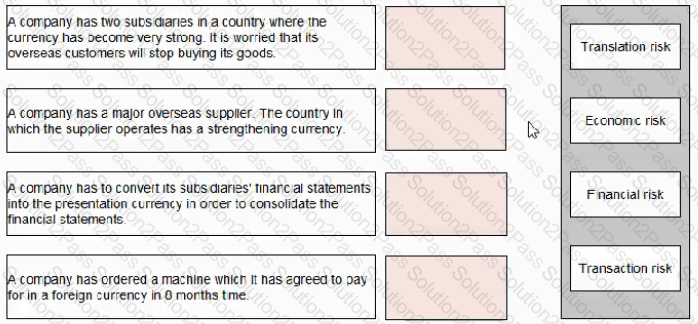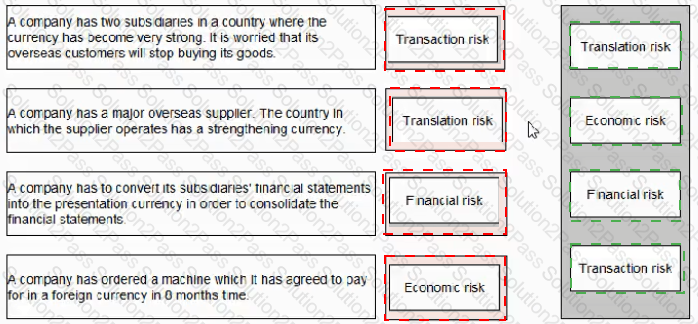F3 CIMA Financial Strategy Free Practice Exam Questions (2025 Updated)
Prepare effectively for your CIMA F3 Financial Strategy certification with our extensive collection of free, high-quality practice questions. Each question is designed to mirror the actual exam format and objectives, complete with comprehensive answers and detailed explanations. Our materials are regularly updated for 2025, ensuring you have the most current resources to build confidence and succeed on your first attempt.
An unlisted company wishes to obtain an estimated value for its shares in anticipation of a private sale of a large parcel of shares.
Relevant data for the unlisted company:
• It has a residual dividend policy.
• It has earnings that are highly sensitive to underlying economic conditions.
• It is a small business in a large industry where there are listed companies but there are none with a similar capital structure.
The company intends to base valuations on the cost of equity of a proxy company after adjusting for any differences in capital structure where appropriate.
Which of the following methods is likely to give the most accurate equity value for this unlisted company?
Three companies are quoted on the New York Stock Exchange. The following data applies:

Which of the following statements is TRUE?
A company's dividend policy is to pay out 50% of its earnings.
Its most recent earnings per share was $0.50, and it has just paid a dividend per share of $0.25.
Currently, dividends are forecast to grow at 2% each year in perpetuity and the cost of equity is 10.5%.
In order to grow its earnings and dividends, the company is considering undertaking a new investment funded entirely by debt finance. If the investment is undertaken:
• Its cost of equity will immediately increase to 12% due to the increased finance risk.
• Its earnings and dividends will immediately commence growing at 4% each year in perpetuity.
Which of the following is the expected percentage change in the share price if the new investment is undertaken?
PYP is a listed courier company. It is looking to raise new finance to fit each of its delivery vans with new equipment to allow improved parcel tracking for customers The senior management team of PYP have decided on a 10-year secured bond to finance this investment-
Which TWO of the following variables are most likely to decrease the yield to maturity of the bond?
The directors of a multinational group have decided to sell off a loss-making subsidiary and are considering the following methods of divestment:
1. Trade sale to an external buyer
2. A management buyout (MBO)
The MBO team and the external buyer have both offered the same price to the parent company for the subsidiary.
Which of the following is an advantage to the parent company of opting for a MBO compared to a trade sale as the preferred method of divestment?
A company s about to announce a new project that has a positive NPV.
If the market is semi-strong form efficient, which of the following statements is most Likely to be true?
The value of the company will.
A consultancy company is dependent for profits and growth on the high value individuals it employs.
The company has relatively few tangible assets.
Select the most appropriate reason for the net asset valuation method being considered unsuitable for such a company.
Assume today is 31 December 20X1.
A listed mobile phone company has just launched a new phone which is proving to be a great success.
As a direct result of the product's success, earnings are forecast to increase by:
• 5% a year in each of years 20X2 – 20X6
• 3% from 20X7 onwards
Market analysts were very excited to hear the news of the success of the product and future growth forecasts.
Assuming a semi-efficient market applies, which of the following company valuation methods is likely to give the best estimate of the company's equity value today?
A company is currently all-equity financed.
The directors are planning to raise long term debt to finance a new project.
The debt:equity ratio after the bond issue would be 40:60 based on estimated market values.
According to Modigliani and Miller's Theory of Capital Structure without tax, the company's cost of equity would:
Company T is a listed company in the retail sector.
Its current profit before interest and taxation is $5 million.
This level of profit is forecast to be maintainable in future.
Company T has a 10% corporate bond in issue with a nominal value of $10 million.
This currently trades at 90% of its nominal value.
Corporate tax is paid at 20%.
The following information is available:

Which of the following is a reasonable expectation of the equity value in the event of an attempted takeover?
Listed company R is in the process of making a cash offer for the equity of unlisted company S.
Company R has a market capitalisation of $200 million and a price/earnings ratio of 10.
Company S has a market capitalisation of $50 million and earnings of $7 million.
Company R intends to offer $60 million and expects to be able to realise synergistic benefits of $20 million by combining the two businesses. This estimate excludes the estimated $8 million cost of integrating the two businesses.
Which of the following figures need to be used when calculating the value of the combined entity in $ millions?
Z wishes to borrow at a floating rate and has been told that it can use swaps to reduce the effective interest rate it pays. Z can borrow floating at Libor ' 1, and fixed at 10%.
Which of the following companies would be the most appropriate for Z to enter into a swap with?
Modigliani and Miller are the main proponents of the view that the dividend policy is irrelevant to the value of a company's shares.
They argue that a company that continually reinvests its entire earnings would generate the same shareholder wealth if it engaged in a policy of high dividends and financed its expansion with funds obtained from rights issues.
Which THREE of the following statements are assumptions that are required in order to support this proposition?
Company M is a geared company whose equity has a market value of $1,500 million and debt has a market value of S300 million. The company plans to issue $200 million of new shares and use the funds raised to pay off some of the debt
Company M currently has a cost of equity of 13% and a WACC of 10% It pays corporate tax at the rate of 30% Company B, an ungeared company operating in the same business sector as Company M, has a cost of equity of 12%
Assume Modigliani and Miller's theory of capital structure with tax applies
Which calculation below shows the correct approach to calculating the new WACC following the planned changes in capital structure?
A

B

C

D

A listed company is planning a share repurchase.
The following data applies:
• There are 10 million shares in issue
• The share repurchase will involve buying back 20% of the shares at a price of $0.75
• The company is holding $2 million cash
• Earnings for the current year ended are $2 million
The Directors are concerned about the impact that this repurchase programme will have on the company's cash balance and current year earnings per share (EPS) ratio.
Advise the directors which of the following statements is correct?
A major energy company, GDE, generates and distributes electricity in country A. The government of country A is concerned about rising inflation and has imposed price controls on GDE, limiting the price it can charge per unit of electricity sold to both domestic and commercial customers. It is likely that price controls will continue for the foreseeable future.
The introduction of price controls is likely to reduce the profit for the current year from $3 billion to $1 billion.
The company has:
• Distributable reserves of $2 billion.
• Surplus cash at the start of the year of $1 billion.
• Plans to pay a total dividend of $1.5 billion in respect of the current year, representing a small annual increase as in previous years. However, no dividends have yet been announced.
Which THREE of the following responses would be MOST appropriate for GDE following the imposition of price controls?
A financial services company reported the following results in its most recent accounting period:

The company has an objective to achieve 5% earnings growth each year. The directors are discussing how this objective might be achieved next year.
Revenues have been flat over the last couple of years as the company has faced difficult trading conditions. Revenue is expected to stay constant in the coming year and so the directors are focussing efforts on reducing costs in an attempt to achieve earnings growth next year.
Interest costs will not change because the company's borrowings are subject to a fixed rate of interest.
What operating profit margin will the company have to achieve next year in order to just achieve its 5% earnings growth objective'?
Company F's current profit before interest and taxation is $5.0 million.
It has a 10% long-term corporate bond in issue with a nominal value of $10 million.
Corporate tax is paid at 25%.
The industry average P/E multiple is 10.
Company X has made an approach to acquire the entire share capital of Company F for $30 million.
Company X has announced that anticipated synergies (after interest and taxation) arising from its acquisition of Company F will be $1 million each year in perpetuity.
Advise the Board of Directors of Company F if the bid should be accepted, based on the above information?
Select the category of risk for each of the descriptions below:

An analyst has valued a company using the free cash flow valuation model.
The analyst used the following data in determining the value:
• Estimated free cashflow in 1 year's time = $100,000
• Estimated growth in free cashflow after the first year = 5% each year indefinitely
• Appropriate cost of equity = 10%
The result produced by the analyst was as follows:
Value of equity = $100,000 (1+0.05)/0.10 = $1,050,000
The analyst made a number of errors in determining the value.
By how much has the analyst undervalued the company?


